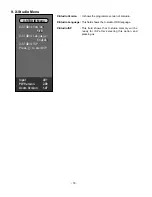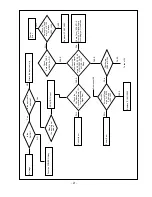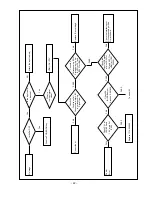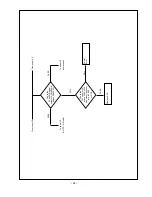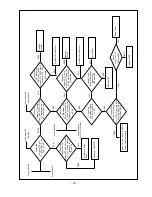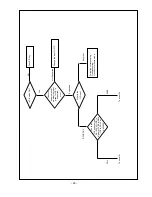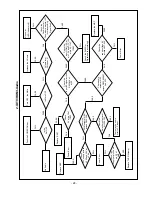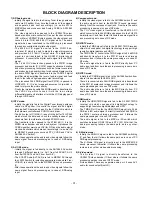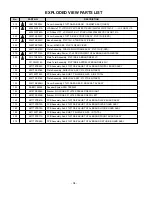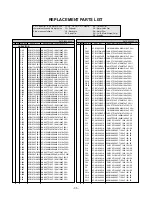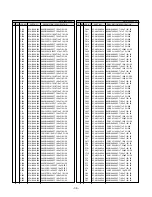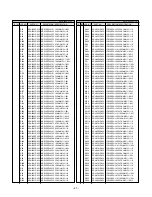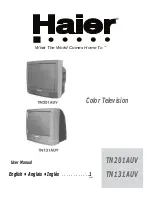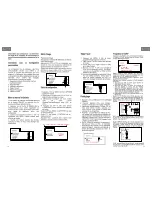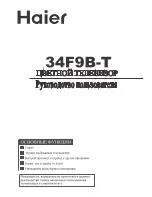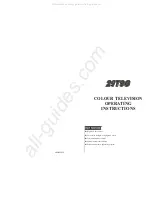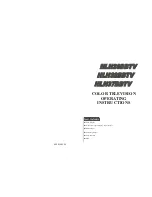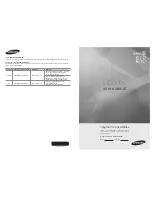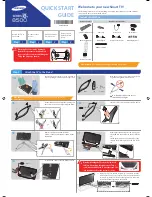
BLOCK DIAGRAM DESCRIPTION
- 31 -
1) RF/Analog mode:
- Initially the signal is fed to the Analog Tuner through antenna
cable via RF splitter. Now, here the Audio and Video signals
are separated and sent accordingly (i.e. audio SIF to
MSP4410sound processor and Analog CVBS to AN15865
AV Switch).
- The video signal is then passed to the VSP9437B colour
decoder and scan rate converter IC as per the user selection
(PiP or Main). VSP9437B chip decodes the video signal and
convert it into ITU-R 656 8bit Y/C signal while, The audio
signal which was transferred to the MSP chip is processed
there and converted into digital audio signal.
- The 656 8bit Y/C signal is now fed to the FLI2310 de-
interlacer IC which is used to make the signal progressive
and provides 4:2:2 16bit YC output while, The digital audio
signal is now transferred to the NSP6241 digital sound
processor. It converts the digital audio signal into the PWM
signal.
- The 16 bit YUV video is then passed to the PW181 image
processor and scalar IC. PW181 supports advanced scaling
and video processing techniques such as format conversion
and producing high quality video for advanced displays while
the audio PWM signal is transferred to the TAS5122 digital
amplifier which amplifies the level of audio signal and feed
them to the left and right speaker output accordingly.
- The processed 24bit RGB signal from PW181 is passed to
LGDP4410 IC. It is an image enhancement chip which is
used to improve the picture quality.
- Finally the improved quality 24bit RGB signal is transferred to
the LVDS chip which convert it into the low voltage
differential signal and interfaces it with the LCD display panel
through LVDS cable.
2) IDTV mode:
- Initially the signal is fed to the Digital Tuner through antenna
cable via RF splitter. It converts the signal into 8bit digital
data (called TS data) and pass it to the CI MAX chip which is
the hardware controller and PCMCIA card driver.
- The 8bit output of CI MAX IC is sent to the buffer 74LVC244
which stores the data and check the validity incase of pay
channels from the information through PCMCIA card.
- The final data is then passed to the STi5516B IC. It is the
MPEG video decoder and audio sub system. It produces the
CVBS signal(for main) and YUV(for PiP) and the audio signal
clocks and controls which are sent accordingly (i.e. audio I2S
to MSP4410 sound processor and DTV_CVBS and YUV to
AN15865 AV Switch).
- After these operations the audio and video signals follow the
same signal flow and processing as in case of RF/Analog
input.
3) AV-1/2/3 mode:
- Initially the signal is fed directly to the AN15865 AV switch
through 3 different inputs (I.e. AV-1 from full SCART, AV-2
from half SCART and AV-3 from front A/V).
- The SCART Audio(AV1,AV2) are fed to MSP4410K through
the LA7222 switch for selecting appropriate mode while Front
LR(AV3) is directly fed to the MSP4410K sound processor
IC.
- After these operations the audio and video signals follow the
same signal flow and processing as in case of RF/Analog
input.
4) Component mode:
- Initially the video signal is fed to the AN15865 switch IC and
the audio signal is sent to the MSP4410 sound processor
directly from the component input jack. From here the audio
processing is same as in case of RF mode.
- The YUV video signal is transferred to the X98014 ADC
which converts it into 24bit RGB and passes it to the FLI2310
de-interlacer IC and from there it follows the same signal flow
and processing as in case of RF mode.
5) DVI/DTV mode:
- Initially the TMDS signal is fed to the SiI 9021 TMDS receiver
chip which uses panel link digital technology to support high
resolution digital displays and HDTV.
- The TMDS Rxr IC converts the TMDS ssignal to 24 bit RGB
anddirectly transfers it to the PW181 scalar and image
processor and it follows the same processing as in case of
RF mode.
- The audio signal here is fed to the MSP directly from PC
audio input and from here the audio processing is same as in
case of RF mode.
6) DVI/PC mode:
- Initially the PC RGB signal is fed to the AN15865 switch from
where it is transferred to X98014 ADC
- There it is converted into 24bit RGB signal and is transferred
to the PW181 scalar and image processor and it follows the
same processing as in case of RF mode.
- The audio signal here is fed to the MSP directly from PC
audio input and from here the audio processing is same as in
case of RF mode.
7) HDMI mode:
- Initially the HDMI TMDS signal is fed to the SiI 9021 TMDS
receiver chip which uses panel link digital technology to
support high resolution digital displays and HDTV.
- The TMDS Rxr IC splits the HDMI TMDS signal into 24 bit
RGB and I2S audio signal It directly transfers 24bit RGB to
the PW181 scalar and image processor and it follows the
same processing as in case of RF mode.
- The audio signal is fed to the MSP via I2S switch which
switches between HDMI I2S and DTV I2S. After that the
audio processing follows the same path as in any other
mode.
8) X-Studio mode:
- Initially the RGB/HV signal is fed to the AN15865 switching
IC and from there it follows the same path as in case of PC
RGB signal processing.
- The X-Studio LR signal is directly input to the MSP4410K
sound processor thereafter it follows the same processing
route as in any other mode audio processing.
9) S-Video mode:
- The S-video YC signal is directly transferred to the
VSP9437B video decoder IC from where it follows the same
processing path as in case of RF/TV mode.
- S-video doesn't have any separate audio port. It uses AV3
audio for sound output(front LR).


